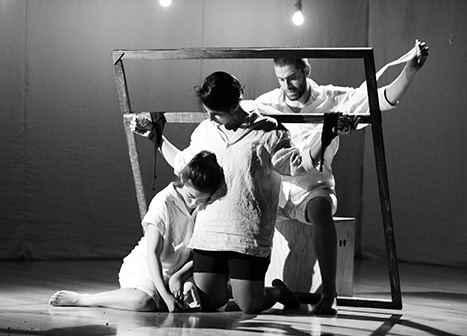
FEMME
first performed on May 4, 2015
Studio 144, NYUAD Arts Center, Abu Dhabi, United Arab Emirates
performed twice in 2015
BROOKS FOWLER / VALENTINA VELA GIRALDO / ATTILIO RIGOTTI / ISABELLA PERALTA
Arianna Stucki, Laura Waltje, Cleo Smits, Julie Stopper, Cristóbal MarYan, Aysan Celik
FEMME
BROOKS FOWLER / VALENTINA VELA GIRALDO / ATTILIO RIGOTTI / ISABELLA PERALTA
“FEMME” is a thirty minute devised performance created through a collaborative and non-hierarchal rehearsal process. It was conceptualized by Brooks with Valentina, Attilio, and Isabella, with Arianna, Laura, Cleo, Julie, and Cristobal as collaborators. Drawing its dramaturgy from durational artwork, Christian iconography, and contemporary gender theory, “FEMME” viscerally embodies collisions of masculinity and femininity in the structure of a queered crucifixion, with the proposition that a loom can stand analogous to a cross. The Gossip’s heavy cross played on repeat during the creation process, and the arc of a weight, a fall, and a crisis, gave a framework to propose alternative masculinities and femininities. “FEMME” originated from the death of my grandfather, my rediscovery of Lutheran faith, and my own questions on the ethics of trans masculinity.
----
I watched The Last Temptation of Christ in December 2014, two months before rehearsals for “FEMME” started. It was 2AM, and I realized the central image of loom as analogous to a cross was, in fact, a queered crucifixion, and that was the backbone of the piece. This queered crucifixion entered a third space between icons of masculinity and femininity, and forefronted the liminal space between the two. If an atypical masculinity is put on trial by the femme, it is there that reversals and upheavals can exist—with the possibility for transformation, confirmation, or removal of masculinity from the space. Our creation process was framed through devising and collaboration. In the room we understood devising as a collage of text, image, bodies, and design. There was a goal of undoing the rigid hierarchies and constructions of gender, and so it didn’t make sense to reproduce a rigid hierarchy in the rehearsal room—instead; there was a weaving together of being an artist in the room and filling the role designated to you as actor/designer/dramaturg.
Gender and faith are questions that have been orbiting in either their presence or absence my whole life—as well as in the hearts of my collaborators—from a body rejecting the masculine aspects of femininity, to trying to hold onto femininity in my masculine identity. We re-framed these concepts as propositions, and looked to see how they collided, cohered, and evolved. It is in the liminal spaces of intersections that embodied transgressions of gender and faith can take place.